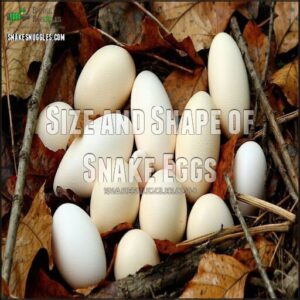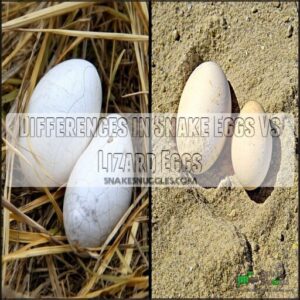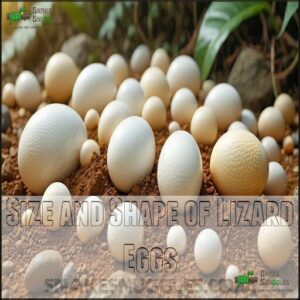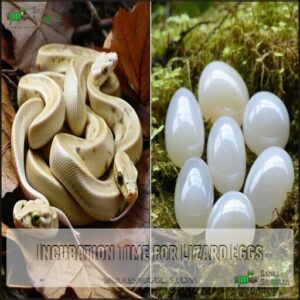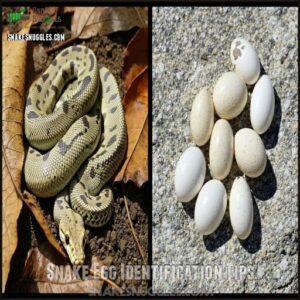This site is supported by our readers. We may earn a commission, at no cost to you, if you purchase through links.

Snake eggs are usually oval, leathery, and soft, while lizard eggs tend to be smaller, rounder, and sometimes harder, resembling tiny ping-pong balls.
Snakes lay their eggs in hidden, warm spots like decomposing logs or underground burrows.
Lizards, on the other hand, often choose less humid areas like sandy soil or under rocks.
If you find eggs but aren’t sure which they are, the shape, texture, and location offer essential clues to help you stay curious—there’s more to uncover about these fascinating reptiles!
Table Of Contents
- Key Takeaways
- Identifying Snake Eggs
- Lizard Egg Characteristics
- Snake Eggs Vs Lizard Eggs
- What to Do if You Find Snake Eggs
- Snake Egg Identification Tips
- Frequently Asked Questions (FAQs)
- How do you identify a snake egg?
- What do lizard eggs look like?
- How to tell a snake from a lizard?
- Are lizard eggs soft or hard?
- How big are snake eggs compared to lizard eggs?
- How to tell the difference between a lizard and a snake?
- How big do lizard eggs get?
- What is the difference between a lizard and a snake egg?
- How do you tell lizard eggs from snake eggs?
- Are lizard eggs rubbery?
- Conclusion
Key Takeaways
- Snake eggs are soft, elongated, and usually clustered in warm, humid spots like compost heaps or under logs.
- Lizard eggs are smaller, rounder, and sometimes firmer, often laid in sandy soil or under rocks.
- Check the texture: snake eggs are leathery and dentable, while lizard eggs can feel rubbery or chalky depending on the species.
- Use the environment as a clue—snakes prefer hidden, moist areas, while lizards tend to choose less humid, exposed nesting sites.
Identifying Snake Eggs
When identifying snake eggs, pay attention to their elongated shape and soft, leathery texture.
Snake eggs stand out with their elongated shape, soft leathery texture, and clustered arrangement in warm, hidden spots.
They’re usually white or off-white and found clumped together in warm, dark, and humid spots like compost heaps or under logs.
Size and Shape of Snake Eggs
Snake eggs are unique in their size and shape, often ranging from 1 to 5 inches in length.
Their elongated oval form, with curved ends, is a standout feature compared to the smaller, rounder lizard eggs. Species differences create egg size variations, but snake eggs always appear more stretched.
Here’s what to look for:
- Egg Length: Larger than most reptile eggs, sometimes up to 5 inches.
- Shape Variation: Always more oval than round.
- Clutch Traits: Eggs grouped tightly together, not scattered.
These clues make identifying snake eggs easy!
Color and Texture of Snake Eggs
When identifying eggs from snakes, focus on their color variations and shell texture, as these offer key clues.
Most snake eggs are a clean white or cream, occasionally showing pale yellow or faint pink—a delicate palette nature loves to surprise us with.
Their egg appearance is complemented by a leathery shell that feels soft and flexible. This smoothness aids moisture absorption, essential for embryo development.
Notably, egg texture variations can occur in drier environments, making shells slightly rougher. The eggs’ incubation period averages around 57 days.
Here’s a quick breakdown:
| Feature | Details |
|---|---|
| Shell Color | White, Cream, Pale Yellow, Pink |
| Shell Texture | Leathery, Smooth, Slightly Rough |
Paying attention to these details guarantees better understanding of egg viability and identification.
Common Locations for Snake Eggs
In the process of choosing nesting sites, snakes are real experts at finding safe, cozy spots.
Their leathery snake eggs need warm, humid, and hidden environments to develop properly, making the selection of these spots vital for survival.
You’re likely to find snake eggs in these dark spaces and hidden spots:
- Compost heaps, where warmth from decomposing material creates an ideal incubator.
- Rotting logs, which offer moisture and protection from predators.
- Soil nests in loose dirt, allowing proper airflow for embryo development.
- Under rocks, providing cover and stable temperatures.
- Abandoned rodent burrows, offering a humid, insulated environment.
Spotting these nesting sites is key for snake egg identification or understanding their habitat. If discovered, observe without disturbance—snake egg care matters!
Differences in Snake Eggs Vs Lizard Eggs
Telling snake eggs apart from lizard eggs might seem tricky, but it’s not rocket science.
When doing a reptile egg comparison, look closely at the shell composition, size, and texture. Snake eggs are soft, leathery, and typically oblong, measuring about 1-5 inches, while lizard eggs are smaller, firmer, and oval or round, often under an inch.
Snake eggs cluster tightly, which helps retain moisture, while lizard eggs are usually spaced apart. Color also plays a role in snake egg identification—snake eggs are white or off-white, while lizard eggs have more variety, from beige to speckled or even light green.
Here are some key differences:
- Snake Eggs: Soft, elongated, clustered, 1-5 inches.
- Lizard Eggs: Firmer, rounder, spaced out, under 1 inch.
- Extra Clues: Snake eggs dent when touched; lizard eggs don’t.
Check for egg viability and think twice before handling these fascinating finds.
Lizard Egg Characteristics
Lizard eggs are usually small and oval, with sizes ranging from 0.4 to 1.2 inches depending on the species.
Their shells can vary from soft and rubbery to hard and chalky, often appearing white, beige, or lightly speckled.
Size and Shape of Lizard Eggs
In the context of lizard eggs, their size and shape offer a fascinating glimpse into nature’s diversity.
Most lizard eggs are smaller than snake eggs, with typical egg dimensions ranging between 0.4-1.2 inches (1-3 cm).
Egg size ranges vary depending on the species, female lizard size, and environmental factors.
You’ll find shapes ranging from oval to slightly round, unlike the elongated look of many snake eggs.
Some species like geckos lay soft, round eggs, while others, like monitors, produce elongated, flexible ones.
Shell thickness also changes depending on nesting environments, with some eggs having soft, leathery shells while others boast firmer coverings.
Grass snake eggs are known for their leathery shells.
| Species | Average Size | Egg Shape Variations |
|---|---|---|
| Geckos | 0.5 inches | Round, soft |
| Iguanas | 1.4 inches | Oval, leathery |
| Anoles | 0.8 inches | Slim, flexible |
| Monitors | 1.6 inches | Elongated, pliable |
The adaptability in lizard egg size and shape helps species thrive in diverse habitats.
This unique characteristic is a result of evolutionary pressures and species-specific traits.
The variation in egg size and shape is also influenced by female lizard size and nesting environments.
Understanding these factors is crucial for conservation efforts and species preservation.
Color and Texture of Lizard Eggs
Let’s talk about the beauty of lizard eggs. Their color variations range from white to beige, with some showing light brown or subtle speckled patterns. These shades often hint at the species and their environment.
When you examine the eggshell texture, you’ll notice it can feel soft and leathery or even chalky.
Lizard eggs adapt to where they’re laid:
- White or beige egg color, sometimes with speckles.
- Softer surfaces in humid conditions.
- Chalky shells in drier environments.
- A thin membrane allows visibility inside.
- Eggshell hardness varies by habitat.
Though small, these eggs are durable, blending perfectly into their surroundings. Their texture changes help maintain just the right moisture for development.
Incubation Time for Lizard Eggs
Lizard egg incubation takes 40-60 days, with temperature sensitivity playing a key role.
Keep the temperature stable at 80-90°F, as species variation means some embryos develop best within this range.
Humidity influence is equally important; aim for 50-70% to prevent incubation failures.
Notably, certain species experience sex changes based on incubation period temperatures. Proper lizard egg incubation increases hatching success, so consistent warmth and moisture are essential for strong, healthy reptile egg incubation.
Unique Features of Lizard Eggs
Lizard eggs have fascinating traits that make them unique in the reptile world.
Here’s a quick lizard egg overview to help you understand:
- Shell Variations: While snake eggs are soft and leathery, lizard eggs range from flexible membranes to calcium-rich, hardened shells depending on the species.
- Color Patterns: Unlike the plain white of snake eggs, lizard eggs often display beige, brown, or speckled patterns, offering natural camouflage in their nesting locations.
- Incubation Humidity: Different species have unique humidity needs. For example, gecko eggs thrive in drier conditions compared to others.
- Lizard Egg Size: At just 1-3 cm, these small wonders are easy to overlook but are engineering marvels—each breaking open to release babies ready to either scatter or stay near siblings.
Snake Eggs Vs Lizard Eggs
You can tell snake eggs and lizard eggs apart by their size, shape, and shell texture.
Snake eggs are usually larger and elongated, while lizard eggs tend to be smaller and rounder, with some variations depending on the species.
Key Differences in Egg Size and Shape
Snake eggs and lizard eggs have clear differences in size and shape that can help you identify them easily.
Snake eggs are elongated, typically 1-5 inches long, while lizard eggs are smaller, ranging from 0.4-1.2 inches, and more rounded.
| Feature | Snake Eggs | Lizard Eggs |
|---|---|---|
| Length | 1-5 inches | 0.4-1.2 inches |
| Shape | Elongated, oval | Rounded, spherical |
| Shell Texture | Soft, leathery | Soft to firm |
| Volume | Larger | Smaller |
Remember, snake eggs have a softer, leathery shell, while lizard eggs can be firmer depending on the species.
Grass snake eggs, for example, are known for their creamy white color.
Color Variations in Snake and Lizard Eggs
Egg color offers great clues when comparing snake egg vs lizard egg characteristics.
Snake eggs stick to simpler colors, usually white or cream, with no markings.
This uniformity often relates to genetic factors and viability indicators, ensuring healthy development.
Lizard eggs, in contrast, showcase more variety.
You might spot them in shades of white, beige, or even pale green, sometimes adorned with speckles.
These pigment sources often tie back to environmental influence and camouflage purposes, helping protect the eggs from predators.
Here’s a quick guide:
| Species | Egg Color | Shell Texture |
|---|---|---|
| Corn Snake | Pearl White | Smooth, Leathery |
| Green Iguana | Pale Green | Slightly Speckled |
| Ball Python | Cream-Yellow | Soft, Flexible |
| Gecko | Off-White/Beige | Often Translucent |
| King Cobra | Dirty White | Leathery, Pliable |
Understanding egg color differences helps decode nature’s clever design and provides insights into the development and protection of eggs, making it a crucial aspect of studying reptiles and their reproductive strategies.
Incubation Times for Snake and Lizard Eggs
Timing plays a big role in hatching success and incubation length for snake and lizard eggs.
Snake egg incubation usually lasts 45-70 days, while lizard egg incubation ranges from 40-60 days.
Temperature sensitivity and humidity needs substantially influence incubation time, with warmer temperatures speeding up the process.
Here’s a quick comparison:
Species variation affects egg incubation duration and development conditions, which are crucial for successful breeding and require careful consideration of ideal temperature.
Environmental Factors for Egg-Laying
In terms of finding the perfect spot for egg-laying, environmental conditions play a huge role in ensuring survival.
Both snakes and lizards carefully select nesting sites that meet their species’ needs for temperature, moisture levels, and safety from predators.
Here’s a quick comparison:
| Factor | Snake Eggs | Lizard Eggs |
|---|---|---|
| Temperature | 78-84°F | 75-90°F |
| Humidity | 70-90% | 50-70% |
| Nesting Substrates | Loose, moist soil | Shallow, arid burrows |
Snake eggs prefer hidden spots like compost piles or decomposing leaves, while lizard eggs often turn up in garden beds or crevices.
Both rely on ideal humidity and temperature gradients to thrive.
What to Do if You Find Snake Eggs
If you come across snake eggs, it’s important to observe them carefully without touching or disturbing them. Contact a local wildlife expert or herpetologist for accurate identification and guidance.
Observe snake eggs with care—no touching! Let experts handle identification to protect delicate embryos and ensure their survival.
Observing Snake Eggs From a Distance
When you spot potential snake eggs, keeping your distance is key. Stay at least six feet away to guarantee snake safety and avoid disturbance consequences.
Use your phone’s zoom or a wildlife camera for remote observation. Detailed photos can help with identification and documenting snake behavior.
Look for helpful visual clues:
- Shape: Snake eggs are elongated, typically oblong.
- Color: Commonly white or off-white.
- Arrangement: Often clustered together.
Thoroughly scan the area for any adult snakes nearby. When taking pictures, aim for natural lighting and include a size reference like a coin or key.
Respect wildlife by avoiding egg disturbance. Photographic evidence can later aid in expert consultation or further identification, guaranteeing safe and effective egg observation.
Avoiding Disturbance of Snake Eggs
When you come across snake eggs, it’s tempting to investigate—but resist the urge.
Handling or moving these eggs can damage their soft, leathery shells or disrupt the precise humidity and temperature levels they need to survive. Even accidental contact can expose them to harmful bacteria, potentially harming the embryos inside. Supporting ecosystem biodiversity is essential for their survival.
| Action | Consequence |
|---|---|
| Touching eggs | Damages delicate shells |
| Moving eggs | Disrupts temperature |
| Taking eggs | Risks harming ecosystems |
Instead, maintain a safe distance and stay mindful of nesting season.
Snapping a quick photo can help with identification while respecting wildlife laws and relocation ethics. Remember, protecting their natural habitat is just as important as your curiosity.
Seeking Professional Help for Snake Egg Identification
If you’ve spotted potential snake eggs, it’s time to let the experts step in. Identifying snake eggs without proper knowledge can be tricky—and knowing whether they’re venomous is critical. Professional help guarantees you’re making the right call.
Here’s how to seek expert guidance:
- Contact local herpetologists through conservation organizations or nearby universities. They can often identify eggs from clear photos.
- Use wildlife removal services for safe handling and accurate egg identification onsite.
- Reach out to university experts who specialize in reptiles and may assist with more obscure species.
- Join communities like online reptile or herpetology groups where enthusiasts share identification tips.
Take multiple, well-lit photos of the eggs from different angles. Professionals can then determine whether you’re handling snake or lizard eggs and guide your next steps. Consider the potential consultation costs when seeking expert advice.
Importance of Leaving Snakes Alone
When you stumble across snake eggs, it’s best to step back and let nature do its thing.
Handling them can disturb the ecological balance and pose venomous risks if adults are nearby.
Snakes are protected in many areas due to their role in conservation efforts, like controlling pests.
Whether the eggs are snake or lizard, always prioritize respecting wildlife, adhering to legal protections, and leaving egg identification to professionals.
Snake Egg Identification Tips
You can identify snake eggs by examining their size, shape, color, and texture, as well as considering where they’re found.
Comparing them directly with lizard eggs or asking a herpetologist can also provide accurate answers.
Using Facebook Groups for Identification
Facebook groups are an excellent way to solve the mystery of any reptile eggs you’ve discovered. To improve Group ID accuracy, start with high-quality, well-lit photos of your find from various angles. Photo quality matters more than you’d think.
Don’t forget to include notes about where you found them, since location helps with snake egg identification or lizard egg identification. Many local expert groups respond quickly and can spot subtle details.
However, handling misinformation is key—always verify advice with reliable sources. Remember that proper incubation temperatures are essential for successful hatching.
When reporting egg finds, politely ask members for their thoughts but avoid touching the eggs.
- Take clear, close-up photos.
- Include location details.
- Join trusted niche groups.
- Verify multiple opinions.
- Share environmental clues.
Consulting Herpetologists and Snake Removal Services
Not sure if you’ve found snake or lizard eggs? Don’t worry—reaching out to wildlife experts like herpetologists guarantees accurate identification and safe handling.
These professionals specialize in species identification, offering practical help when you’re unsure what’s in your yard.
Herpetologist expertise comes with benefits like:
- Safe handling: They know how to protect you and delicate eggs.
- Professional consultation: Experts use scientific methods, guaranteeing precise species identification.
- Snake relocation: If necessary, they ethically move eggs from inconvenient or unsafe spots.
Many wildlife removal services also handle venomous snake eggs, offering peace of mind through strict protocols.
Knowing the average consultation costs can help you budget for expert advice.
Local university zoology departments or wildlife organizations may even provide free egg identification—just reach out for professional help.
Direct Side-by-Side Comparison for Accurate Identification
In the context of egg identification, comparing them side-by-side is the most straightforward way to distinguish snake eggs from lizard eggs.
By focusing on visible and tactile differences, you can identify them accurately.
Here’s how to spot key differences:
- Size Comparison: Snake eggs are larger, ranging from 1 to 5 inches long, while lizard eggs are much smaller, typically under 1.2 inches.
- Shape Differences: Snake eggs are elongated, like a tic-tac; lizard eggs are rounder or oval.
- Shell Texture: Snake eggs feel soft, leathery, and slightly squishy, while lizard eggs might feel rubbery or chalky.
- Color Range: Snake eggs are plain white, while lizard eggs often display speckles, beige, or even brownish tones.
For assistance, consider using an egg identification tool.
Egg distinguishing features become clearer with practice!
Considering Environmental Cues for Egg-Laying Sites
Identifying snake eggs often depends on understanding the environmental conditions they need. Snakes almost always choose nesting sites carefully, aiming for places with the right mix of moisture levels, soil composition, and predator avoidance.
Typically, snakes prefer dark, humid spots that offer stable temperature and humidity. They love rotting logs, compost piles, and abandoned burrows where humidity stays high (70-90%) and temperatures range from 78-84°F.
Here’s a quick comparison of snake and lizard nesting preferences:
| Feature | Snake Eggs | Lizard Eggs |
|---|---|---|
| Moisture Levels | High (70-90%) | Moderate (50-70%) |
| Soil Composition | Soft, rotting logs | Sandy, loose soil |
| Sunlight Exposure | Shaded areas | Varies, some exposed |
These environmentally secure nesting sites guarantee proper egg development while hiding eggs from predators. By knowing the cues snakes use for egg deposition—like nesting materials and sunlight exposure—you’ll better identify these reptilian treasures.
Frequently Asked Questions (FAQs)
How do you identify a snake egg?
You can recognize a snake egg by its elongated, soft, leathery shell.
It’s dentable, not brittle, usually white or off-white, and often found in moist, dark spots like rotting logs or soil.
What do lizard eggs look like?
Lizard eggs are small, oval, and usually white, beige, or light brown.
Their shells vary from soft and leathery to slightly chalky.
You’ll often find them in sandy soil, shallow burrows, or protected areas.
How to tell a snake from a lizard?
Think of it like spotting sneakers from boots—snakes lack legs and eyelids, while lizards have both.
Lizards often blink and run, whereas snakes slither smoothly.
Focus on movement, body shape, and physical features.
Are lizard eggs soft or hard?
Their texture depends on the species.
Some lizard eggs feel firm and chalky, while others are softer and more rubbery.
They’re delicate either way, so handle with care to avoid damaging the developing embryos inside.
How big are snake eggs compared to lizard eggs?
Snake eggs are like Nature’s weird jellybeans, larger and elongated, usually 1-5 inches long.
Lizard eggs are smaller, 4-2 inches, rounder, and often chalkier.
Clearly, size-wise, snakes win the reptile egg Olympics!
How to tell the difference between a lizard and a snake?
You can spot the difference by looking at movement and body shape.
Snakes are legless with smooth, elongated bodies, while lizards have legs, visible eyelids, and external ear openings.
Snakes slither; lizards often scamper.
How big do lizard eggs get?
Lizard eggs vary in size, usually reaching 4 to 2 inches long.
Their size depends on the species, but they’re typically small, round, or oval-shaped with soft, leathery shells—sometimes chalky for specific species.
What is the difference between a lizard and a snake egg?
Snake eggs are longer, soft, and leathery, while lizard eggs are smaller, rounder, and sometimes chalky.
Snake eggs cluster tightly, staying moist, while lizard eggs are often scattered or laid loosely, suiting their environments better, which can be considered a key factor in their environments.
How do you tell lizard eggs from snake eggs?
Imagine finding smooth, leathery eggs in damp soil—snake eggs are oblong and soft, while lizard eggs are smaller, rounder, and may feel chalkier.
Check the shape, size, and texture to tell them apart.
Are lizard eggs rubbery?
Yes, they’re usually soft and rubbery.
Depending on the species, their texture can vary slightly, but they’re not as brittle as bird eggs, making them more flexible and durable in natural environments.
Conclusion
Imagine stumbling upon a mystery clutch of eggs—Mother Nature’s version of a treasure hunt.
To tell snake eggs vs lizard eggs apart, focus on size, shape, and texture.
Snake eggs are longer and softer, while lizard eggs are rounder and firmer.
Environmental clues like humid logs or sandy soil also help identify them.
With this knowledge, you’re better equipped to observe responsibly and remember that these eggs are essential to our planet’s fascinating reptile diversity.
Remember, always leave eggs undisturbed—they’re essential to our planet’s fascinating reptile diversity.
- https://www.sydney.edu.au/news-opinion/news/2020/04/22/egg-laying-lizard-also-gives-live-birth-is-this-evolution-before-our-eyes.html
- https://singapore.biodiversity.online/taxo4254/mainSpace/Bronchocela%20cristatella.html
- https://wildlifeinformer.com/can-you-eat-snake-eggs/
- https://www.researchgate.net/publication/11024580_Energy_and_nutrient_utilisation_in_reptiles
- https://www.britannica.com/list/9-of-the-worlds-deadliest-snakes

